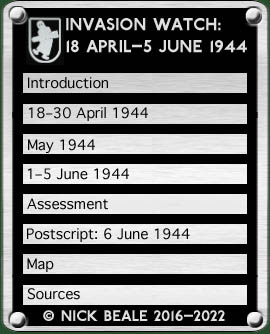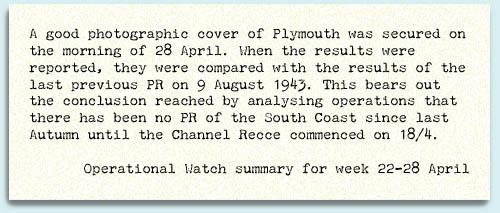|
Notably more active, NAG 13 sent pairs of fighters to Plymouth (0635–0759) and Penzance (0931–1046), two more Rotten made overwater sorties late in the afternoon; more unusually a group of three was up from 1506–1604. The Penzance mission was abandoned after an hour owing to cloud, the Bf 109s returning to base. There was no action reported elsewhere in the Channel but the coverage of Plymouth proved conspicuously successful. At 0707, radar tracked aircraft 80 km south of the city, heading north to make landfall at Stoke Point. In the harbour they were able to photograph three battleships, seven cruisers, 17 destroyers, two monitors, six escorts, 11 LST, 11 small landing craft, 13 freighters and numerous small craft. At RAF Mountbatten, Plymouth,there were 10 Sunderland flying boats. As a bonus, they were able to report 10 eastbound merchant vessels in the Channel. Although the Messerschmitts had been attacked from ahead by two fighters at very low level, neither side had opened fire. Acting on the photos obtained, 101 Luftwaffe bombers raided Plymouth on the night of the 29/30th. 29 April A renewed attempt to get coverage of Penzance succeeded, two NAG 13 Bf 109s leaving Dinard at 1400 and an hour later photographing the coast from Gunwalloe to Newlyn from 7800 m. Only a handful of small ships was in port at Penzance but Newlyn accommodated 45 small craft and auxiliary landing craft; on the return flight they saw a rubber dinghy with about 10 dead bodies aboard. Why these smaller Cornish ports were prioritised over the major (and as yet unphotographed) docks and anchorage of nearby Falmouth and Carrick Roads is far from obvious. During an evening mission, an aircraft was warned by its controller of a “sailing boat” south of the Isle of Wight; the Y-Service took this to be some kind of code word. On Guernsey, 1./NAG 13’s Fw 190 F-1, W.Nr. 013 0392, was 70% damaged in a crash and handed over to the local salvage unit. 30 April Late in the afternoon, Stab NAG 13 mounted two overwater reconnaissances of two Bf 109 each without seeing any shipping. Both formations reported that defending fighters had been searching for them. FAG 123 also sent up a Bf 109 Rotte during the evening, with a similar absence of results; again the British overheard an “immediate recall” message. As the month ended, Stab NAG 13 reported recently taking over five Bf 109s: W.Nr. 160876 (NT+_B), 161441 (NP+UL), 162067 (RW+DP) and 15648 (DR+CN), all with Rb 12.5/7 x 9 cameras; and W.Nr. 161429 (NP+ZC) which lacked both MW 50 boost and an Identification Friend or Foe set. Meanwhile, 4.(F)/123 was asking for a new DB 605 engine for Bf 109 G-4 W.Nr. 19401. An unnamed Staffel received Bf 109 G-5 W.Nr. 110346 from Guyancourt, this one properly fitted out with its radio gear, GM 1 boost, Rb 50/30 and an MG 151/20 cannon.
Assessing the month’s efforts, the British attributed the “particularly striking” increase in NAG 13’s sortie rate to the recent arrival of the 3. Staffel on the Channel coast. Meanwhile, 3.(F)/122’s night security reconnaissance had become “a routine operation” but had failed to secure any significant results. The reconnaissance units' strengths on 30 April were:
continued on next page …
|
|||||||||||||||||||||||||


